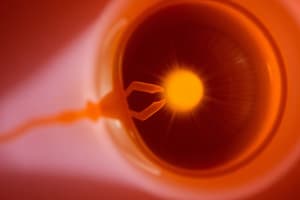Podcast
Questions and Answers
What type of storage device is a hard drive often referred to as?
What type of storage device is a hard drive often referred to as?
- Volatile
- Non-volatile (correct)
- Sequential access
- Random access
Which component inside a hard drive is responsible for moving back and forth to find data?
Which component inside a hard drive is responsible for moving back and forth to find data?
- Spindle
- Platters
- Actuator arms (correct)
- Random access
What creates limitations on the speed of retrieving and storing data in a hard drive?
What creates limitations on the speed of retrieving and storing data in a hard drive?
- Data spinning
- Non-volatility
- Moving parts and mechanical components (correct)
- Random access
Why does a hard drive eventually fail?
Why does a hard drive eventually fail?
What is not recommended to use flash drives for?
What is not recommended to use flash drives for?
What type of storage offers the ability to rewrite or change information?
What type of storage offers the ability to rewrite or change information?
Which type of flash memory is commonly used in mobile phones?
Which type of flash memory is commonly used in mobile phones?
What is the purpose of RAID arrays?
What is the purpose of RAID arrays?
Which type of RAID does not provide redundancy?
Which type of RAID does not provide redundancy?
In RAID 0, how is data distributed among the drives?
In RAID 0, how is data distributed among the drives?
Which type of storage device uses a laser to read information?
Which type of storage device uses a laser to read information?
What is a disadvantage of using flash drives for archival storage?
What is a disadvantage of using flash drives for archival storage?
'RAID' stands for?
'RAID' stands for?
'SD' in 'SD card' stands for?
'SD' in 'SD card' stands for?
What do optical disks store?
What do optical disks store?
What does RAID 0 do?
What does RAID 0 do?
What is the function of the actuator on the hard drive?
What is the function of the actuator on the hard drive?
What component is used to locate, retrieve, and write data precisely on the spinning platters?
What component is used to locate, retrieve, and write data precisely on the spinning platters?
How does the rotational speed of the platters affect data retrieval speed?
How does the rotational speed of the platters affect data retrieval speed?
What is the rotational latency when a hard drive spins at 15,000 rotations per minute?
What is the rotational latency when a hard drive spins at 15,000 rotations per minute?
What type of drive has no moving parts inside and offers faster performance than traditional hard drives?
What type of drive has no moving parts inside and offers faster performance than traditional hard drives?
Which interface type is typically used to access an SSD?
Which interface type is typically used to access an SSD?
What is the advantage of having an mSATA interface over a SATA interface?
What is the advantage of having an mSATA interface over a SATA interface?
Which component of the hard drive allows reading and writing from every spot on spinning platters?
Which component of the hard drive allows reading and writing from every spot on spinning platters?
What is one significant advantage of an SSD over a traditional hard drive?
What is one significant advantage of an SSD over a traditional hard drive?
What does the SATA interface offer for SSDs?
What does the SATA interface offer for SSDs?
What led to the development of mSATA as an alternative to SATA?
What led to the development of mSATA as an alternative to SATA?
What does AHCI stand for in the context of SATA technology?
What does AHCI stand for in the context of SATA technology?
Which type of interface does an SSD typically connect to for higher throughput compared to SATA?
Which type of interface does an SSD typically connect to for higher throughput compared to SATA?
What advantage does M.2 interface have over a traditional SATA connection?
What advantage does M.2 interface have over a traditional SATA connection?
What is the purpose of NVMe in the context of SSD technology?
What is the purpose of NVMe in the context of SSD technology?
Why do we use M.2 interface instead of traditional SATA connections?
Why do we use M.2 interface instead of traditional SATA connections?
What type of memory is flash memory technically classified as?
What type of memory is flash memory technically classified as?
What happens to the data stored in flash memory when there is no power supply?
What happens to the data stored in flash memory when there is no power supply?
What is one concern associated with writing information to flash memory?
What is one concern associated with writing information to flash memory?
What is one advantage of using an M.2 interface over a traditional SATA connection when connecting an SSD?
What is one advantage of using an M.2 interface over a traditional SATA connection when connecting an SSD?
What technology was developed to address the limitation of SATA connections when communicating with high-speed SSDs?
What technology was developed to address the limitation of SATA connections when communicating with high-speed SSDs?
Which key type is crucial to ensure maximum throughput when using an M.2-based SSD?
Which key type is crucial to ensure maximum throughput when using an M.2-based SSD?
What is the primary purpose of NVMe in enhancing SSD performance?
What is the primary purpose of NVMe in enhancing SSD performance?
What happens if one drive fails in a RAID 0 configuration?
What happens if one drive fails in a RAID 0 configuration?
How does RAID 1 differ from RAID 0 in terms of data storage?
How does RAID 1 differ from RAID 0 in terms of data storage?
What is the primary difference between RAID 1 and RAID 0?
What is the primary difference between RAID 1 and RAID 0?
How does RAID 5 differ from RAID 0 and RAID 1?
How does RAID 5 differ from RAID 0 and RAID 1?
What is the purpose of parity information in RAID 5?
What is the purpose of parity information in RAID 5?
Which RAID type combines the features of mirroring and striping?
Which RAID type combines the features of mirroring and striping?
What is the advantage of using RAID 1 in terms of data availability?
What is the advantage of using RAID 1 in terms of data availability?
Why is RAID 5 considered more efficient in terms of drive space utilization compared to RAID 1?
Why is RAID 5 considered more efficient in terms of drive space utilization compared to RAID 1?
In RAID 10, how many copies of each stripe of data are stored?
In RAID 10, how many copies of each stripe of data are stored?
What makes RAID 10 more resilient to multiple drive failures compared to other RAID types?
What makes RAID 10 more resilient to multiple drive failures compared to other RAID types?



